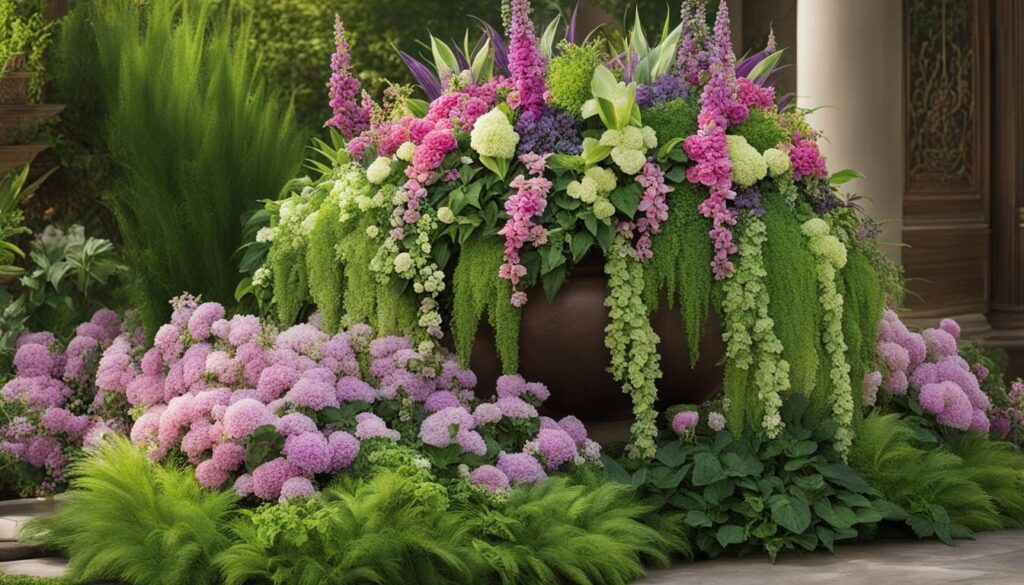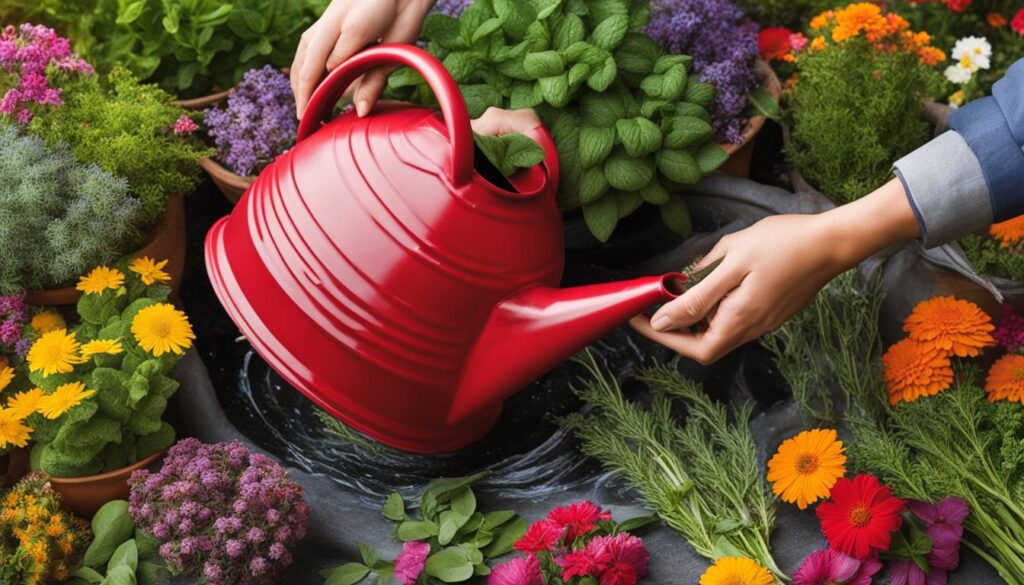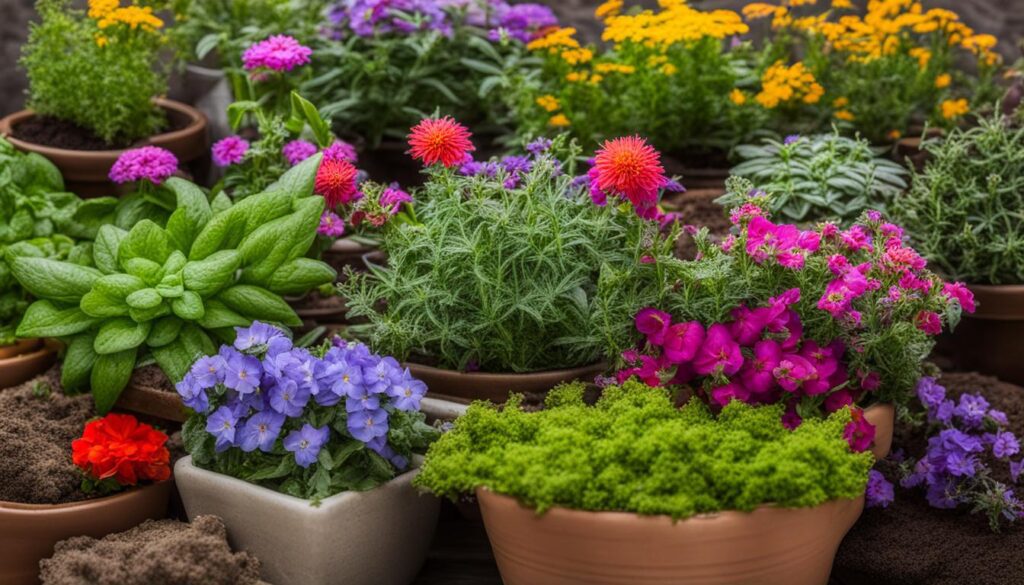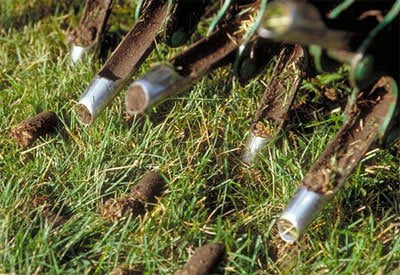Are you looking to add a touch of beauty and versatility to your garden? Have you considered planting herbs and flowers together in pots? Container gardening offers a fantastic opportunity to maximize impact in limited spaces while creating stunning mixed container gardens. In this article, we will explore the essential techniques and tips to help you master the art of planting herbs and flowers together in pots.
Key Takeaways:
- Container gardening allows you to maximize impact in limited spaces.
- Mixed container gardens with herbs and flowers add visual interest and serve as focal points.
- Selecting the right containers, choosing suitable plants, and providing proper care are crucial for successful herb and flower combinations.
- Consider the specific needs of different herbs and flowers when selecting plants for mixed containers.
- Proper watering, nutrition, pruning, and pest control techniques are essential for the health and growth of herbs and flowers in pots.
Selecting the Right Containers for Herb and Flower Combinations
When planting herbs and flowers together in pots, choosing the right containers is crucial. The container selection plays a significant role in the successful growth of your mixed container garden. Here are some key factors to consider when selecting containers for your herb and flower combinations:
Container Size
Pot size is an important consideration. Most herbs and flowers thrive in shallow pots, but some plants may require larger containers for optimal growth. It is recommended to choose containers that are at least 8 inches deep to allow for robust root development. However, make sure to research the specific needs of each herb and flower you intend to plant together, as some plants may have specific depth requirements.
Drainage Holes
Another essential feature to look for in containers is proper drainage. Without adequate drainage, excess water can accumulate in the pot, leading to root rot and other issues. Ensure that your containers have drainage holes to allow excess water to escape. This will help prevent waterlogging and promote healthy growth.
Lightweight Materials
Consider the weight of the containers, especially if you plan to move them around. Lightweight materials, such as plastic or clay, are recommended for ease of movement. These lighter containers will allow you to position your mixed container garden in different spots as per your preference and changes in sunlight exposure throughout the day.
By selecting containers that are the right size, have proper drainage, and are made of lightweight materials, you can create an ideal environment for your herb and flower combinations to thrive. Now that you have the right containers, let’s move on to the next step: choosing the perfect plants for your mixed container garden.
Choosing the Right Plants for Mixed Container Gardens
When creating mixed container gardens with herbs and flowers, it’s important to choose suitable plants that will thrive together. Consider the specific needs of each plant and how they will complement each other in terms of sunlight, water requirements, and growth habits. By selecting the right plant pairs, you can create a harmonious and visually appealing container garden.
In herb garden pots, it’s essential to choose plants that have similar care needs. Some popular herb combinations include basil and thyme, parsley and chives, and rosemary and lavender. These pairs not only have similar watering and sunlight requirements, but they also complement each other in terms of fragrance and culinary uses. Combining flowers with herbs can also add color and attract pollinators to your garden. Marigolds, petunias, and pansies are popular flower options that pair well with herbs.
Best Herbs and Flowers for Container Gardens
- Basil and Thyme
- Parsley and Chives
- Rosemary and Lavender
- Marigolds
- Petunias
- Pansies
When selecting plants for mixed container gardens, it’s also important to consider the amount of direct sunlight each plant requires. Choose a location that receives at least 4-6 hours of sunlight daily for optimal growth. Some herbs, like basil and parsley, prefer full sun, while others, like cilantro and mint, can tolerate partial shade. Flowers have varying sunlight requirements as well, so be sure to choose plants that have similar light preferences to ensure they thrive together.
By carefully selecting suitable plants for your mixed container gardens, you can create a beautiful and functional space that showcases the best of both herbs and flowers. Consider their care needs and compatibility to ensure successful growth and a visually stunning display.
Using the Right Soil for Herb and Flower Combinations
Choosing the correct soil for your herb and flower combinations is essential for their growth and overall health. Using potting soil specifically designed for container gardening is recommended, as it provides proper drainage and aeration for the plants. Avoid using 100 percent garden soil, as it can become compacted and hinder root development. Instead, opt for a well-draining mix that includes a combination of garden soil, compost, perlite or coarse sand, and peat moss or coco coir.
Creating your own potting mix can also be a cost-effective option. Mix two parts garden soil with one part compost, and add a handful of perlite or coarse sand to improve drainage. Incorporate peat moss or coco coir to enhance moisture retention. This DIY mix ensures that your herbs and flowers receive the necessary nutrients and have proper access to air and water.
When using potting soil, it’s important to note that some plants may have specific soil requirements. For example, acid-loving plants like azaleas and blueberries prefer acidic soil, while succulents thrive in sandy soil with excellent drainage. Consider the specific needs of the herbs and flowers in your mixed container garden to achieve the best results.
Table: Soil Composition for Herb and Flower Combinations
| Soil Component | Description |
|---|---|
| Potting Soil | A well-draining mix formulated for container gardening. |
| Garden Soil | Avoid using 100 percent garden soil as it can become compacted and impede drainage. |
| Compost | Add organic matter to improve soil fertility and moisture retention. |
| Perlite or Coarse Sand | Enhances soil drainage and aeration. |
| Peat Moss or Coco Coir | Improves moisture retention in the soil. |
Proper Watering Techniques for Herb and Flower Combinations
Proper watering is essential for the health and vitality of your herb and flower combinations in containers. Understanding the watering needs of your plants and maintaining the ideal soil moisture level will ensure their successful growth and development. Here are some important tips to help you master the art of watering:
1. Check Soil Moisture Regularly
Consistently monitor the moisture level of the soil by inserting your finger about an inch into the potting mix. If it feels dry at that depth, it’s time to water your plants. Remember, different herbs and flowers have varying watering requirements, so it’s crucial to assess the needs of each individual plant.
2. Water Thoroughly
When watering your container gardens, ensure that you water thoroughly. This means applying water until it begins to flow out of the drainage holes at the bottom of the container. Thorough watering helps to ensure that the entire root system receives adequate moisture.
3. Provide Proper Drainage
Good drainage is essential to prevent overwatering and root rot. Make sure your containers have sufficient drainage holes to allow excess water to escape. Elevating the pots with pot feet or placing them on a layer of gravel can also improve drainage.
4. Avoid Underwatering and Overwatering
Striking the right balance between underwatering and overwatering is crucial. Underwatering can lead to stunted growth and wilting, while overwatering can suffocate the roots and cause root rot. Remember to adjust your watering frequency based on the specific needs of your plants and the environmental conditions.
| Signs of Underwatering | Signs of Overwatering |
|---|---|
| – Wilting leaves – Dry, crumbly soil – Stunted growth |
– Yellowing leaves – Mushy or rotting roots – Foul odor from soil |
| “Underwatering can lead to stunted growth and wilting.” | “Overwatering can suffocate the roots and cause root rot.” |
Remember that different plants have different watering needs, so it’s important to tailor your watering routine to suit each individual species. By following these proper watering techniques, you’ll be able to successfully nurture your herbs and flowers in containers and enjoy a flourishing, vibrant garden.
Providing Adequate Nutrition for Herb and Flower Combinations
Proper nutrition is essential for the healthy growth of herb and flower combinations in containers. By providing the right balance of nutrients, you can ensure that your plants thrive and produce vibrant foliage and blossoms. There are various options for fertilizing herbs and flowers in mixed container gardens, including water-soluble fertilizers and organic alternatives.
Fertilizing with Water-Soluble Fertilizers
Water-soluble fertilizers are a convenient and effective option for providing balanced nutrients to your herb and flower combinations. These fertilizers are dissolved in water and applied to the soil, allowing the plants to easily absorb the essential nutrients. When choosing a water-soluble fertilizer, look for a formula specifically designed for container plants. Dilute the fertilizer to half the recommended strength to avoid over-fertilization, as excessive nutrients can cause leaf burn and other issues.
Exploring Organic Fertilizers
If you prefer organic gardening methods, there are several options for fertilizing your herb and flower combinations. Organic fertilizers, such as compost and well-rotted manure, provide slow-release nutrients that nourish the plants over time. You can mix these organic materials into the potting soil at the time of planting or apply them as a top dressing throughout the growing season. Additionally, organic liquid fertilizers made from natural ingredients are available and can be used according to the manufacturer’s instructions.
Regardless of the type of fertilizer you choose, it’s important to follow the instructions for application and frequency. Over-fertilizing can lead to nutrient imbalances and may harm your plants. Always monitor your herb and flower combinations for signs of nutrient deficiencies or excesses, such as yellowing leaves or stunted growth, and adjust your fertilization routine accordingly.
| Fertilizer Type | Advantages | Considerations |
|---|---|---|
| Water-soluble fertilizers | Convenient and easy to apply. Provides quick nutrient uptake for plants. | May require frequent applications throughout the growing season. Overuse can cause nutrient imbalances. |
| Organic fertilizers | Nourishes plants over time with slow-release nutrients. Promotes soil health and microbial activity. | May take longer to see effects compared to synthetic fertilizers. Requires proper composting or sourcing of organic materials. |
Remember, providing adequate nutrition is just one aspect of caring for your herb and flower combinations. Regular watering, pruning, and pest control are equally important for maintaining healthy and flourishing container gardens. By following a holistic approach to plant care, you can create stunning mixed containers that bring beauty and joy to your outdoor space.
Pruning, Pinching, and Pest Control for Herb and Flower Combinations
Pruning and pinching are essential techniques for maintaining the health and appearance of your herb and flower combinations. Regularly pruning or pinching terminal shoots helps promote bushy growth, prevent legginess, and prolong the harvesting period. By removing the tips of stems, you encourage branching and encourage the plants to grow fuller, resulting in a more abundant herb yield and more blooms from your flowers.
“Pruning encourages new growth and strengthens the plants,” says experienced gardener Jane Johnson. “Pinching also ensures that the plants remain compact and don’t become too tall or spindly.”
When it comes to pest control, container herbs and flowers are not immune to insect infestations. Regular inspection is crucial to catch pest problems early. Look for signs of chewed leaves, holes, or discolored foliage. If you detect pests, such as aphids, mites, or caterpillars, take immediate action to prevent them from spreading.
There are effective organic pest control methods that you can employ to protect your plants. For instance, you can introduce beneficial insects like ladybugs or lacewings that feed on harmful pests. Another option is to make your own insecticidal soap using mild detergent and water. Remember to follow the instructions carefully when using any pest control methods to ensure the safety of your plants.
Common Insect Pests in Container Gardens
Here are some common insect pests that can be problematic in container herb and flower gardens:
| Insect Pest | Description | Control |
|---|---|---|
| Aphids | Small, soft-bodied insects that suck sap from plants, causing curled leaves and stunted growth. | Introduce ladybugs or use insecticidal soap. |
| Spider Mites | Microscopic pests that thrive in hot, dry conditions, causing yellowed leaves and webbing. | Boost humidity and apply insecticidal soap or neem oil. |
| Caterpillars | Larvae of butterflies or moths that eat foliage, leaving ragged edges and holes. | Remove by hand or use organic caterpillar-specific pesticides. |
By practicing regular pruning, implementing effective pest control measures, and maintaining a close watch on your plants, you can ensure that your herb and flower combinations thrive and remain healthy in your container garden.
Can Canna Lilies and Calla Lilies Be Planted Together in the Same Pot?
Yes, Canna Lilies and Calla Lilies can be planted together in the same pot, making it a beautiful canna vs calla lily choice for gardeners. Both plants have similar care requirements and can thrive in the same growing conditions, creating a stunning and vibrant combination of colors and textures.
Conclusion
Planting herbs and flowers together in pots can elevate the beauty and versatility of your garden. By carefully selecting the right containers, choosing suitable plants, providing proper care, and following the right techniques, you can create stunning mixed container gardens that will be the envy of all.
Experiment with different combinations, textures, and themes to unleash your creativity and elevate your gardening skills. From vibrant herb and flower pairings to harmonious color schemes, the possibilities are endless. The joy of container gardening lies in the ability to customize and beautify any space, no matter how limited.
Remember these container gardening tips as you embark on your herb and flower combinations. Select containers with good drainage and appropriate sizes. Choose plants that thrive together and provide them with the right amount of sunlight, water, and nutrients. Don’t forget the importance of pruning, pinching, and pest control to maintain healthy growth.
So, embrace the wonders of mixed container gardening and let your imagination run wild. Enjoy the satisfaction of growing herbs and flowers together in pots, and create a visual masterpiece that will bring joy and inspiration to your life and surroundings. Happy gardening!
FAQ
What type of containers should I use for planting herbs and flowers together?
It is recommended to choose lightweight containers made of clay or plastic with good drainage capabilities.
How deep should the containers be for herb and flower combinations?
The containers should be at least 8 inches deep to allow for robust root development.
Can I grow different herbs in the same pot?
Yes, you can grow different herbs in the same pot as long as each plant gets proper nourishment.
How much sunlight do herbs and flowers in containers need?
Choose a location that receives at least 4-6 hours of sunlight daily for optimal growth.
What type of soil should I use for herb and flower combinations?
Avoid using 100 percent garden soil and instead use a well-draining potting mix formulated for container gardening or create your own mix using garden soil, compost, perlite or coarse sand, and peat moss or coco coir.
How often should I water herbs and flowers in containers?
Check the moisture level of the soil by inserting your finger about an inch into the soil and water thoroughly if it feels dry at that depth. Watering needs may vary for different plants.
What type of fertilizer should I use for herb and flower combinations in pots?
Use a balanced, water-soluble fertilizer specifically designed for container plants. Dilute the fertilizer to half the recommended strength to avoid over-fertilization.
How can I encourage bushy growth in container herbs and flowers?
Regularly prune or pinch terminal shoots to promote lush foliage and prevent legginess.
How can I manage pest infestations in container herbs and flowers?
Inspect plants regularly for signs of infestation and take immediate action if pests are detected. Consider organic pest control methods and use insecticidal soap when necessary.












